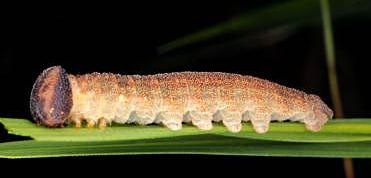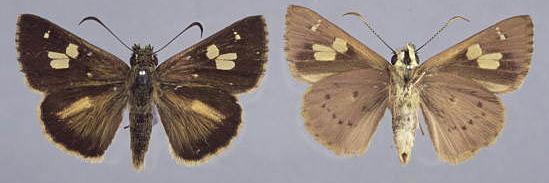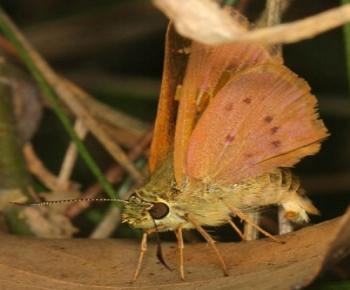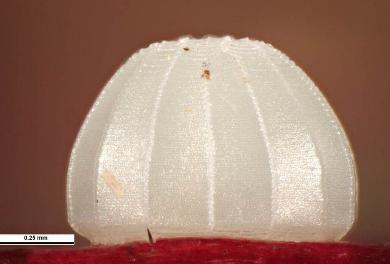
| Bright Shield-skipper (previously known as Telesto flammeata and Signeta flammeata) TRAPEZITINAE, HESPERIIDAE, HESPERIOIDEA | (donherbisonevans@yahoo.com) and Stella Crossley |

(Photo: courtesy of R.Field,
Museums Victoria)

| Bright Shield-skipper (previously known as Telesto flammeata and Signeta flammeata) TRAPEZITINAE, HESPERIIDAE, HESPERIOIDEA | (donherbisonevans@yahoo.com) and Stella Crossley |

(Photo: courtesy of R.Field,
Museums Victoria)
The Caterpillar of this species is brown with a darker brown line along the back. The head is black with brown markings and is indented. The Caterpillar grows to a length of about 1.5 cms. It feeds on grasses such as
all of POACEAE.
The Caterpillar resides by day in a shelter of grass stems held together loosely with silk, feeding nocturnally. It pupates in its shelter.

The upper surface of the adult butterfly is dark brown, with white patches on the fore wings. The male also has a large black patch on each fore wing, and the female has a pale yellow patch on each hind wing. Underneath, the wings are a paler brown, the fore wings having pale yellow patches, and the hind wings having a subterminal arc of dark dots. The wing span is about 3 cms.

Males of this species, like those of several other species of butterflies, seem particularly fond of aggregating at hill tops.

The eggs are white, developing coloured patches as hatching approaches. The eggs are shaped like partly squashed spheres with ribs. The eggs have a diameter of about 0.7 mm. They are laid singly on discarded gum leaves or branches or other debris on the ground near tussocks of a foodplant.

The species may be found particularly in the hill country along the south-east coast of Australia including:
Further reading :
Michael F. Braby,
Butterflies of Australia,
CSIRO Publishing, Melbourne 2000, vol. 1, pp 139-140.
Arthur G. Butler,
On a small collection of Lepidoptera from Melbourne.,
Annals and Magazine of Natural History,
Series 5, Volume 9 (1882), pp. 85-86, No. 7 (383).
 caterpillar |  butterflies |  Lepidoptera |  moths |  caterpillar |
(updated 19 March 2011, 3 April 2025)